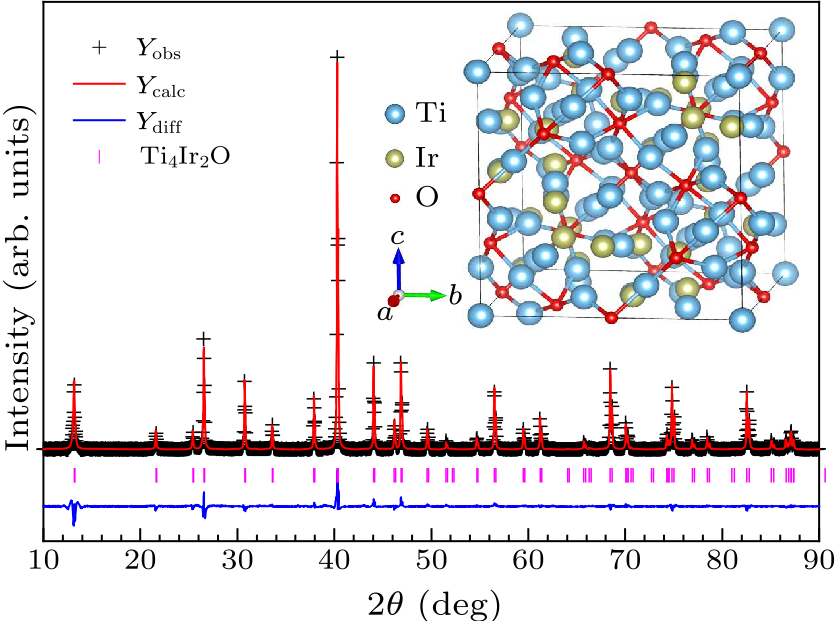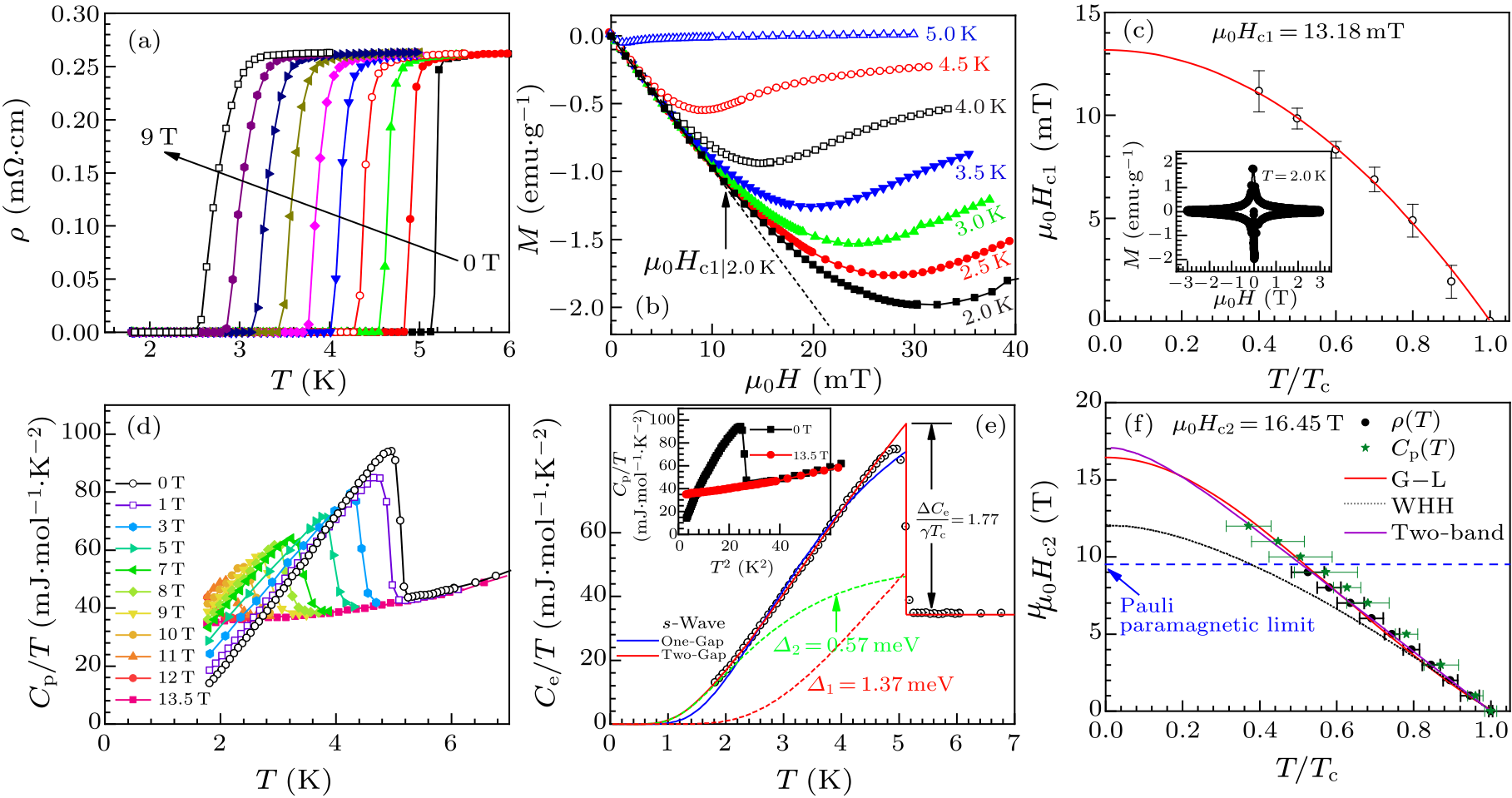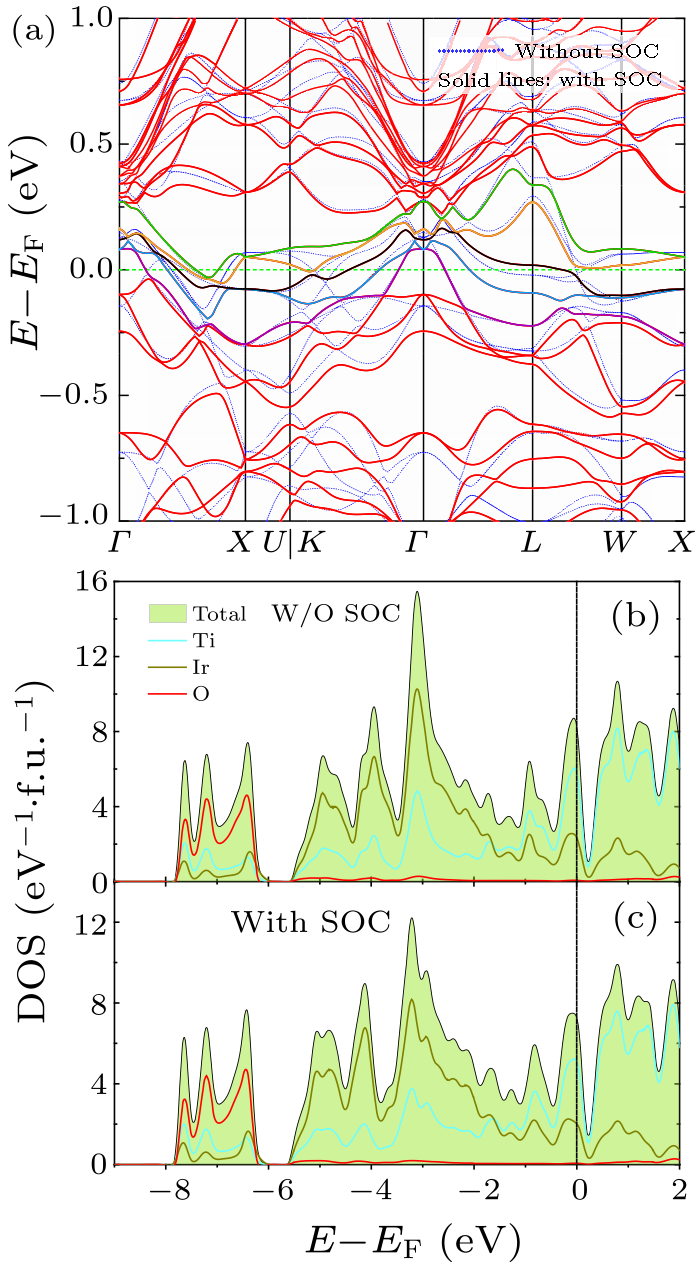




Fig. 1. Room-temperature XRD pattern of Ti$_4$Ir$_2$O and its Rietveld refinements. $Y_{\rm obs}$, $Y_{\rm calc}$, and $Y_{\rm diff}$ stand for the observed intensity, the calculated intensity, and the difference between them, respectively. The vertical bars indicate the Bragg positions for $\eta$-carbide type Ti$_4$Ir$_2$O. The conventional unit cell is shown as the inset.
| Space group | $Fd\bar{3}m$ (No. 227) | |||
|---|---|---|---|---|
| $a$ (Å) | 11.6194(1) | |||
| $a_{_{\scriptstyle \rm w/o-SOC}}$ (Å) | 11.5562 | |||
| $a_{_{\scriptstyle \rm with-SOC}}$ (Å) | 11.5531 | |||
| Atom (position) | $x$ | $U_{\rm eq}$ (0.01 Å$^2$) | $x_{_{\scriptstyle \rm w/o-SOC}}$ | $x_{_{\scriptstyle \rm with-SOC}}$ |
| Ti1 (16$c$) | 0 | 0.348(60) | 0 | 0 |
| Ti2 (48$f$) | 0.4412(2) | 0.065(25) | 0.4428 | 0.4419 |
| Ir (32$e$) | 0.2145(0) | 0.276(24) | 0.2160 | 0.2159 |
| O (16$d$) | 0.5 | 0.633(150) | 0.5 | 0.5 |

Fig. 2. (a) Temperature dependence of resistivity of Ti$_4$Ir$_2$O under zero magnetic field. Normal state data below 35 K can be described by Eq. (1), as shown in the inset. (b) Temperature dependence of DC magnetic susceptibility of Ti$_4$Ir$_2$O at low temperatures. Inset shows the temperature dependence of the normal state magnetization from 8 K to 300 K.

Fig. 3. (a) Superconducting transition on $\rho(T)$ under magnetic fields from 0 T to 9 T, the field increment between each curve is 1 T. (b) Isothermal magnetization under different temperatures. The dashed line shows the initial Meissner states. (c) Lower critical fields ($H_{\rm c1}$) under different temperatures, and the fit according to the G–L relation. Inset shows the isothermal magnetization loop at 2.0 K. (d) Low temperature heat capacity under magnetic fields from 0 T to 13.5 T. (e) Electronic contribution of heat capacity at zero magnetic field. Solid curves show fits based on a one-gap s-wave model (blue), and a two-gap s-wave model (red). Contributions from the two gaps are displayed as dotted curves. (f) Upper critical fields ($H_{\rm c2}$) under different temperatures, determined by $\rho(T)$ and $C_{\rm p}(T)$. The fitting curves are based on the $\rho(T)$ data, according to the G–L (red), WHH (dotted), and two-band (purple) models, respectively. The value of $\mu_0H_{\rm c2}(0)$ is from the G–L fit.
| Parameter | Value | Notes |
|---|---|---|
| $T_{\rm c}^{\rm onset}$ (K) | 5.22 | |
| $T_{\rm c}^{\rm zero}$ (K) | 5.13 | From $\rho(T)~(T_{\rm c}$ ranges from 5.1 K to 5.7 K in samples prepared with |
| different methods, see the Supplementary Material) | ||
| $T_{\rm c}^{\rm mag}$ (K) | 5.12 | From $\chi(T)$ |
| $T_{\rm c}^{\rm HC}$ (K) | 5.12 | From $C_{\rm e}(T)$ |
| $\mu_0H_{\rm c1}(0)$ (mT) | 13.18 | From G–L fit |
| $\mu_0H_{\rm c2}(0)$ (T) | 16.45 | From G–L fit |
| $\mu_0H_{\rm c}(0)$ (T) | 0.23 | |
| $\xi_{_{\scriptstyle \rm GL}}$ (nm) | 4.47 | |
| $\lambda_{_{\scriptstyle \rm GL}}$ (nm) | 236.1 | |
| $\kappa_{_{\scriptstyle \rm GL}}$ | 52.8 | |
| $\gamma$ (mJ$\cdot$mol$^{-1}\cdot$K$^{-2}$) | 33.74 | |
| $\beta$ (mJ$\cdot$mol$^{-1}$$\cdot$K$^{-4}$) | 0.265 | |
| $\varTheta_{\rm D}$ (K) | 372 | |
| $\lambda_{\rm ep}$ | 0.61 | |
| $\Delta C_{\rm e}/\gamma T_{\rm c}$ | 1.77 | |
| $\varDelta_1/k_{\scriptscriptstyle{\rm B}}T_{\rm c}$ | 3.10 | |
| $\varDelta_2/k_{\scriptscriptstyle{\rm B}}T_{\rm c}$ | 1.29 | |
| $N(E_{\rm F})$ (eV$^{-1}$ per f.u.) | 8.83 | Experimental value deduced from $\gamma$ |
| $N'(E_{\rm F})$ (eV$^{-1}$ per f.u.) | 7.26 | Theoretical value from DFT calculation with SOC |

Fig. 4. (a) Electronic band structures of Ti$_4$Ir$_2$O from DFT calculation. Dotted lines show the results without SOC, while the SOC results are shown as solid lines. Solid lines in colors other than red indicate the bands crossing the Fermi level. (b) Projected DOS without SOC. (c) Projected DOS with SOC.
| [1] | Gurevich A 2011 Nat. Mater. 10 255 | To use or not to use cool superconductors?
| [2] | Hahn S, Kim K, Kim K, Hu X, Painter T, Dixon I, Kim S, Bhattarai K R, Noguchi S, Jaroszynski J, and Larbalestier D C 2019 Nature 570 496 | 45.5-tesla direct-current magnetic field generated with a high-temperature superconducting magnet
| [3] | Stewart G 2015 Physica C 514 28 | Superconductivity in the A15 structure
| [4] | Poole C K, Farach H A, and Creswick R J 1999 Handbook of Superconductivity (Amsterdam: Elsevier) |
| [5] | Stewart G, Fisk Z, Willis J, and Smith J 1984 Phys. Rev. Lett. 52 679 | Possibility of Coexistence of Bulk Superconductivity and Spin Fluctuations in U
| [6] | Tao Q, shen J Q, Li L J et al 2009 Chin. Phys. Lett. 26 097401 | Upper Critical Fields and Anisotropy of BaFe1.9Ni0.1As2 Single Crystals
| [7] | Bauer E, Hilscher G, Michor H, Paul C, Scheidt E, Gribanov A, Seropegin Y, Noel H, Sigrist M, and Rogl P 2004 Phys. Rev. Lett. 92 027003 | Heavy Fermion Superconductivity and Magnetic Order in Noncentrosymmetric
| [8] | Gupta R, Ying T, Qi Y, Hosono H, and Khasanov R 2021 Phys. Rev. B 103 174511 | Gap symmetry of the noncentrosymmetric superconductor
| [9] | Bao J K, Liu J Y, Ma C W, Meng Z H, Tang Z T, Sun Y L, Zhai H F, Jiang H, Bai H, Feng C M et al. 2015 Phys. Rev. X 5 011013 | Superconductivity in Quasi-One-Dimensional with Significant Electron Correlations
| [10] | Zhi H, Imai T, Ning F, Bao J K, and Cao G H 2015 Phys. Rev. Lett. 114 147004 | NMR Investigation of the Quasi-One-Dimensional Superconductor
| [11] | Tang Z T, Bao J K, Liu Y, Sun Y L, Ablimit A, Zhai H F, Jiang H, Feng C M, Xu Z A, and Cao G H 2015 Phys. Rev. B 91 020506 | Unconventional superconductivity in quasi-one-dimensional
| [12] | Cao Y, Park J M, Watanabe K, Taniguchi T, and Jarillo-Herrero P 2021 Nature 595 526 | Pauli-limit violation and re-entrant superconductivity in moiré graphene
| [13] | Lu Y, Takayama T, Bangura A F, Katsura Y, Hashizume D, and Takagi H 2014 J. Phys. Soc. Jpn. 83 023702 | Superconductivity at 6 K and the Violation of Pauli Limit in Ta 2 Pd x S 5
| [14] | Okuda K, Kitagawa M, Sakakibara T, and Date M 1980 J. Phys. Soc. Jpn. 48 2157 | Upper Critical Field Measurements up to 600 kG in PbMo 6 S 8
| [15] | Chan Y C, Yip K Y, Cheung Y W, Chan Y T, Niu Q, Kajitani J, Higashinaka R, Matsuda T D, Yanase Y, Aoki Y, Lai K T, and Goh S K 2018 Phys. Rev. B 97 104509 | Anisotropic two-gap superconductivity and the absence of a Pauli paramagnetic limit in single-crystalline
| [16] | Taylor A and Sachs K 1952 Nature 169 411 | A New Complex Eta-Carbide
| [17] | Kuo K 1953 Acta Metall. 1 301 | The formation of η carbides
| [18] | Newsam J, Jacobson A, McCandlish L, and Polizzotti R 1988 J. Solid State Chem. 75 296 | The structures of the η-carbides Ni6Mo6C, Co6Mo6C, and Co6Mo6C2
| [19] | Jeitschko W, Holleck H, Nowotny H, and Benesovsky F 1964 Monatsh. Chem. - Chem. Mon. 95 1004 | Phasen mit aufgef�lltem Ti2Ni-Typ
| [20] | Dubrovinskaia N, Dubrovinsky L, Saxena S, Selleby M, and Sundman B 1999 J. Alloys Compd. 285 242 | Thermal expansion and compressibility of Co6W6C
| [21] | Zavalii I, Verbovytskyi Y, Berezovets V, Shtender V, Pecharsky V, and Lyutyi P 2017 Mater. Sci. 53 306 | Synthesis, Structure, and Hydrogen-Sorption Properties of (Ti,Zr)4Ni2N x Subnitrides
| [22] | Nagai M, Zahidul A M, and Matsuda K 2006 Appl. Catal. A 313 137 | Nano-structured nickel–molybdenum carbide catalyst for low-temperature water-gas shift reaction
| [23] | Ku H and Johnston D 1984 Chin. J. Phys. 22 59 |
| [24] | Ma K, Lago J, and von Rohr F O 2019 J. Alloys Compd. 796 287 | Superconductivity in the η-carbide-type oxides
| [25] | Ma K, Gornicka K, Lefèvre R, Yang Y, Rønnow H M, Jeschke H O, Klimczuk T, and von Rohr F O 2021 ACS Mater. Au 1 55 | Superconductivity with High Upper Critical Field in the Cubic Centrosymmetric η-Carbide Nb 4 Rh 2 C 1−δ
| [26] | Matthias B, Geballe T, and Compton V 1963 Rev. Mod. Phys. 35 1 | Superconductivity
| [27] | Zegler S 1965 J. Phys. Chem. Solids 26 1347 | Superconductivity in zirconium-rhodium alloys
| [28] | Toby B 2001 J. Appl. Crystallogr. 34 210 | EXPGUI , a graphical user interface for GSAS
| [29] | Ruan B B, Yang Q S, Zhou M H, Chen G F, and Ren Z A 2021 J. Alloys Compd. 868 159230 | Superconductivity in a new T2-phase Mo5GeB2
| [30] | Prozorov R and Kogan V G 2018 Phys. Rev. Appl. 10 014030 | Effective Demagnetizing Factors of Diamagnetic Samples of Various Shapes
| [31] | Giannozzi P, Baroni S, Bonini N, Calandra M, Car R, Cavazzoni C, Ceresoli D, Chiarotti G L, Cococcioni M, Dabo I, Dal C A, de Gironcoli S, Fabris S, Fratesi G, Gebauer R, Gerstmann U, Gougoussis C, Kokalj A, Lazzeri M, Martin-Samos L, Marzari N, Mauri F, Mazzarello R, Paolini S, Pasquarello A, Paulatto L, Sbraccia C, Scandolo S, Sclauzero G, Seitsonen A P, Smogunov A, Umari P, and Wentzcovitch R M 2009 J. Phys.: Condens. Matter 21 395502 | QUANTUM ESPRESSO: a modular and open-source software project for quantum simulations of materials
| [32] | Giannozzi P, Andreussi O, Brumme T, Bunau O, Nardelli M B, Calandra M, Car R, Cavazzoni C, Ceresoli D, Cococcioni M, Colonna N, Carnimeo I, Corso A D, de Gironcoli S, Delugas P, DiStasio R A, Ferretti A, Floris A, Fratesi G, Fugallo G, Gebauer R, Gerstmann U, Giustino F, Gorni T, Jia J, Kawamura M, Ko H Y, Kokalj A, Küçükbenli E, Lazzeri M, Marsili M, Marzari N, Mauri F, Nguyen N L, Nguyen H V, Otero-de-la-Roza A, Paulatto L, Poncé S, Rocca D, Sabatini R, Santra B, Schlipf M, Seitsonen A P, Smogunov A, Timrov I, Thonhauser T, Umari P, Vast N, Wu X, and Baroni S 2017 J. Phys.: Condens. Matter 29 465901 | Advanced capabilities for materials modelling with Quantum ESPRESSO
| [33] | Giannozzi P, Baseggio O, Bonfa P, Brunato D, Car R, Carnimeo I, Cavazzoni C, de Gironcoli S, Delugas P, Ruffino F F, Ferretti A, Marzari N, Timrov I, Urru A, and Baroni S 2020 J. Chem. Phys. 152 154105 | Q
| [34] | Perdew J P, Ruzsinszky A, Csonka G I, Vydrov O A, Scuseria G E, Constantin L A, Zhou X, and Burke K 2008 Phys. Rev. Lett. 100 136406 | Restoring the Density-Gradient Expansion for Exchange in Solids and Surfaces
| [35] | Dal C A 2014 Comput. Mater. Sci. 95 337 | Pseudopotentials periodic table: From H to Pu
| [36] | Otero-de-la-Roza A, Johnson E R, and Luana V 2014 Comput. Phys. Commun. 185 1007 | Critic2: A program for real-space analysis of quantum chemical interactions in solids
| [37] | Fuhr J D, Roura-Bas P, and Aligia A A 2021 Phys. Rev. B 103 035126 | Maximally localized Wannier functions for describing a topological phase transition in stanene
| [38] | Pizzi G, Vitale V, Arita R, Bluegel S, Freimuth F, Geranton G, Gibertini M, Gresch D, Johnson C, Koretsune T, Ibanez-Azpiroz J, Lee H, Lihm J M, Marchand D, Marrazzo A, Mokrousov Y, Mustafa I J, Nohara Y, Nomura Y, Paulatto L, Ponce S, Ponweiser T, Qiao J, Thoele F, Tsirkin S S, Wierzbowska M, Marzari N, Vanderbilt D, Souza I, Mostofi A A, and Yates J R 2020 J. Phys.: Condens. Matter 32 165902 | Wannier90 as a community code: new features and applications
| [39] | Okamoto H, Massalski T et al. 1990 Binary Alloy Phase Diagrams (Materials Park, OH: ASM International) |
| [40] | Xu C, Wang H, Tian H, Shi Y, Li Z A, Xiao R, Shi H, Yang H, and Li J 2021 Chin. Phys. B 30 077403 | Superconductivity in an intermetallic oxide Hf 3 Pt 4 Ge 2 O*
| [41] | Carbotte J 1990 Rev. Mod. Phys. 62 1027 | Properties of boson-exchange superconductors
| [42] | Fisk Z and Webb G 1976 Phys. Rev. Lett. 36 1084 | Saturation of the High-Temperature Normal-State Electrical Resistivity of Superconductors
| [43] | Takayama T, Kuwano K, Hirai D, Katsura Y, Yamamoto A, and Takagi H 2012 Phys. Rev. Lett. 108 237001 | Strong Coupling Superconductivity at 8.4 K in an Antiperovskite Phosphide
| [44] | Mott N F, Jones H, Jones H, and Jones H 1958 The Theory of the Properties of Metals and Alloys (Courier Dover Publications) |
| [45] | Mott N F 1964 Adv. Phys. 13 325 | Electrons in transition metals
| [46] | Werthamer N, Helfand E, and PC H 1966 Phys. Rev. 147 288 | Temperature and Purity Dependence of the Superconducting Critical Field, . II
| [47] | Bud'ko S, Petrovic C, Lapertot G, Cunningham C, Canfield P, Jung M, and Lacerda A 2001 Phys. Rev. B 63 220503 | Magnetoresistivity and in
| [48] | Suderow H, Tissen V, Brison J, Martı́nez J, and Vieira S 2005 Phys. Rev. Lett. 95 117006 | Pressure Induced Effects on the Fermi Surface of Superconducting
| [49] | De Faria L R, Ferreira P P, Correa L E, Eleno L T, Torikachvili M S, and Machado A J 2021 Supercond. Sci. Technol. 34 065010 | Possible multiband superconductivity in the quaternary carbide YRe 2 SiC
| [50] | Gurevich A 2003 Phys. Rev. B 67 184515 | Enhancement of the upper critical field by nonmagnetic impurities in dirty two-gap superconductors
| [51] | McMillan W L 1968 Phys. Rev. 167 331 | Transition Temperature of Strong-Coupled Superconductors
| [52] | Mercure J F, Bangura A F, Xu X, Wakeham N, Carrington A, Walmsley P, Greenblatt M, and Hussey N E 2012 Phys. Rev. Lett. 108 187003 | Upper Critical Magnetic Field far above the Paramagnetic Pair-Breaking Limit of Superconducting One-Dimensional Single Crystals
| [53] | Ishikawa H, Wedig U, Nuss J, Kremer R K, Dinnebier R, Blankenhorn M, Pakdaman M, Matsumoto Y, Takayama T, Kitagawa K, and Takagi H 2019 Inorg. Chem. 58 12888 | Superconductivity at 4.8 K and Violation of Pauli Limit in La 2 IRu 2 Comprising Ru Honeycomb Layer
| [54] | Mu Q G, Ruan B B, Zhao K, Pan B J, Liu T, Shan L, Chen G F, and Ren Z A 2018 Sci. Bull. 63 952 | Superconductivity at 10.4 K in a novel quasi-one-dimensional ternary molybdenum pnictide K2Mo3As3
| [55] | Altarawneh M, Harrison N, Li G, Balicas L, Tobash P, Ronning F, and Bauer E 2012 Phys. Rev. Lett. 108 066407 | Superconducting Pairs with Extreme Uniaxial Anisotropy in
| [56] | Anand V K, Adroja D T, and Hillier A D 2012 Phys. Rev. B 85 014418 | Ferromagnetic cluster spin-glass behavior in PrRhSn
| [57] | Tong P, Sun Y P, Zhu X B, and Song W H 2006 Phys. Rev. B 73 245106 | Strong electron-electron correlation in the antiperovskite compound
| [58] | Steglich F, Aarts J, Bredl C, Lieke W, Meschede D, Franz W, and Schafer H 1979 Phys. Rev. Lett. 43 1892 | Superconductivity in the Presence of Strong Pauli Paramagnetism: Ce
| [59] | Ma K, Lefèvre R, Gornicka K, Jeschke H O, Zhang X, Guguchia Z, Klimczuk T, and von Rohr F O 2021 Chem. Mater. 33 8722 | Group-9 Transition-Metal Suboxides Adopting the Filled-Ti 2 Ni Structure: A Class of Superconductors Exhibiting Exceptionally High Upper Critical Fields